Understanding the Pacific Parrotlet: A Complete Guide
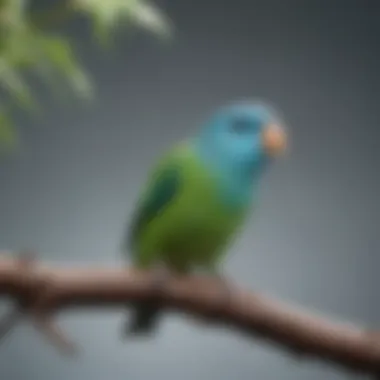
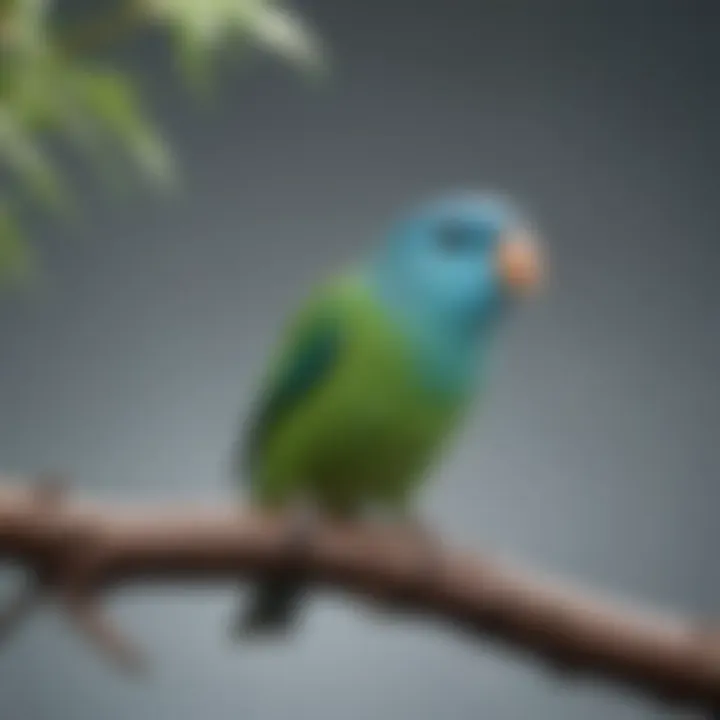
Intro
The Pacific Parrotlet has garnered a cult following among bird lovers, and it’s not hard to see why. These pint-sized parrots boast vibrant personalities that put many larger birds to shame. When it comes to companionship, they are second to none, engaging owners with their clever antics and spirited charm. However, being a Pacific Parrotlet owner is a multifaceted commitment that entails understanding their specific needs and behaviors.
This guide aims to illuminate key aspects of caring for these dynamic creatures, encompassing everything from daily care routines to their nutritional needs and behavioral insights. It’s designed for anyone from seasoned bird breeders to aspiring pet parents – all looking to foster a nurturing environment for their feathered companions.
Care Tips
Caring for a Pacific Parrotlet goes beyond just feeding; it encompasses building a trusting relationship, understanding their quirks, and knowing how to provide a thriving habitat. Here are some essential tips to lay the groundwork for your parrotlet's well-being.
Daily Care Routines
The daily rituals you establish for your parrotlet form the backbone of their care. This small bird thrives on a schedule. Here are some simple routines to consider:
- Morning Mist: Start their day with a gentle misting to mimic natural humidity.
- Feeding: Fresh food should be provided daily, complemented with clean water. Change the water twice a day to ensure freshness.
- Social Time: Spend at least a couple of hours bonding through gentle talking or play.
Cage Setup and Maintenance
An appropriate cage is crucial for your parrotlet’s health and happiness. The cage should be spacious enough to allow for free movement. Aim for at least 24"x24"x24" of space. Include:
- Perches of Various Sizes: Different diameters prevent foot problems.
- Toys: Rotate toys frequently to keep them mentally stimulated.
Regular cage cleaning is vital. Remove waste and leftover food daily, and perform a deeper clean weekly.
Hygiene and Cleaning Practices
Just like we need to keep our living spaces tidy, so do our feathered friends. Regular hygiene practices include:
- Safe Cleaning Agents: Use vinegar or baking soda instead of harsh chemicals.
- Inspect for Mold: Pay attention to corners and crevices where moisture may settle.
Seasonal Care Adjustments
As the seasons shift, so do your parrotlet's needs. Winter might require added warmth, like a cozy corner with blankets, while summer might necessitate extra cooling.
Behavioral Insights
Understanding the body language of a Pacific Parrotlet can make all the difference in fostering a loving relationship. These birds are expressive, using a variety of postures and sounds to communicate.
Understanding Bird Body Language
It's essential to recognize their non-verbal signals. For example, if your parrotlet puffs up its feathers, it may be feeling threatened or cold. A relaxed bird, on the other hand, often has smooth feathers and may even preen itself.
Common Behavioral Issues and Solutions
Like any pets, parrotlets can have their fair share of behavioral issues. Common challenges include:
- Biting: Usually a sign of fear; work on building trust through gentle interaction.
- Chirping Excessively: This could reflect boredom; more interaction or toys may help.
Positive Reinforcement Techniques
Training your parrotlet using positive reinforcement can yield remarkable results. Employ treats or praise to reward good behavior. This not only encourages desired actions but also strengthens your bond.
Social Interaction Needs
Social creatures, Pacific Parrotlets thrive on interaction. Spend adequate time engaging them, and remember that these birds usually do better in the company of their human caretakers, or ideally, other parrots.
"The more you invest time in understanding a Pacific Parrotlet, the richer your relationship will become."
Nutrition Guides
Feeding your Pacific Parrotlet the right diet is fundamental in ensuring their overall health. The key components of an ideal diet include fresh fruits, vegetables, seeds, and formulated pellets designed for small parrots.
Essential Diet Components
- Pellets: Should serve as the mainstay of their diet. Seek high-quality options that include a variety of ingredients.
- Fresh Greens: Dark leafy greens like kale and spinach can provide the necessary vitamins.
Safe and Toxic Foods
Know what your feathered friend can and cannot munch on. Safe foods include apple slices, carrots, broccoli, while chocolate, avocado, and caffeine should be strictly avoided.
Supplements and Treats
Occasional treats can enrich your parrotlet's life. Nutritional supplements, like calcium and omega-3s, can be beneficial, especially during molting.
Feeding Strategies for Different Species
Each parrotlet species may have slight variations in dietary needs. Research specific diets to ensure optimal health for your particular bird.
Wellness and Health
Keeping an eye on your parrotlet's health is paramount. Regular wellness checks and knowledge of what symptoms to look out for can lead to early intervention when something seems off.
Routine Health Checkups
Just as we do with pets, regular check-ups with an avian vet can prevent many issues before they become serious. Early diagnosis often means easier treatment.
Identifying Symptoms of Illness
Be alert for signs such as:
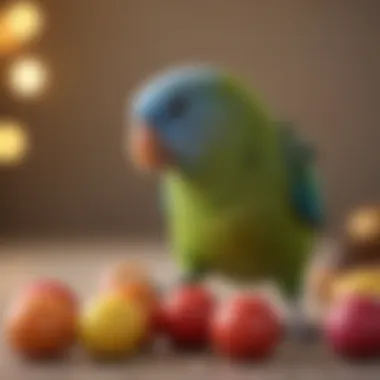
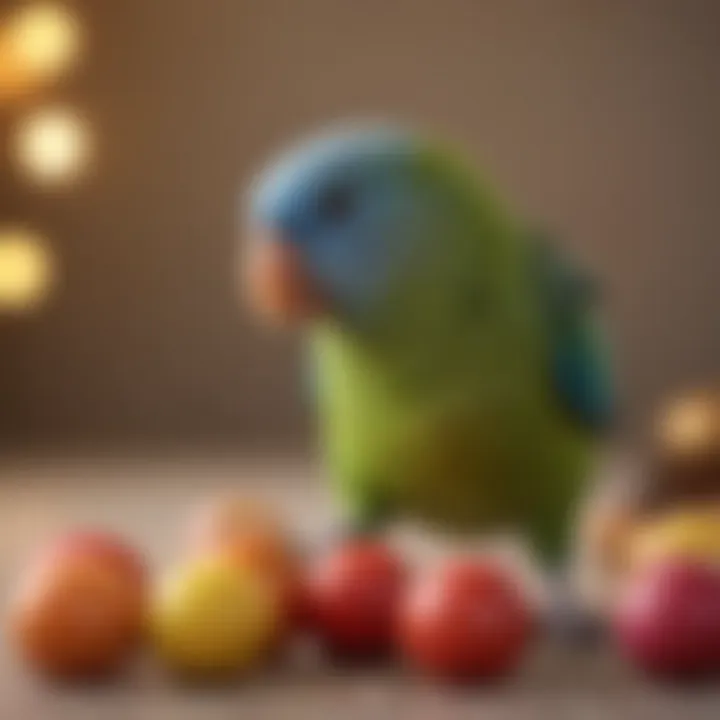
- Change in eating habits
- Feather loss or dullness
- Changes in behavior like lethargy
Preventative Care and Vaccinations
Discuss vaccination schedules with your vet to stay ahead of common avian diseases.
Mental and Emotional Well-being
Don’t underestimate the importance of providing an enriched environment. This not only prevents boredom but supports emotional health.
Enriching Activities
To keep a Pacific Parrotlet stimulated, enriching activities are key. The goal is to engage their minds and bodies.
Toys and Playtime Ideas
Invest in a variety of toys to keep your parrotlet engaged. Options like foraging toys can make mealtime more interesting.
Training and Tricks
Teaching tricks can act as both exercise and mental stimulation. Start with simple commands and reward your bird for success.
Outdoor Activities and Interaction
Supervised outdoor time can give your parrotlet new sights and sounds to explore. Use aviaries or secure harnesses when venturing outside.
DIY Projects for Mental Stimulation
Creating your own toys or challenges can be rewarding for both you and your bird. Use household items like paper towel rolls stuffed with treats as fun puzzles.
Understanding the ins and outs of caring for a Pacific Parrotlet requires effort, but the rewards are immeasurable. As you delve deeper into the world of parrots, not only will you be better equipped to meet their needs, but you will also cultivate a bond that lasts a lifetime.
Prologue to the Pacific Parrotlet
When diving into the world of avian companions, the Pacific Parrotlet stands out not just for its size but also for its vibrant personality and intelligence. This section acts as a gateway into understanding this captivating species, offering benefits and considerations that pet bird owners must keep in mind. By providing a foundation of knowledge, it can greatly enhance one’s experience with these little feathered marvels.
Overview of the Species
The Pacific Parrotlet, often referred to as a parrotlet, is one of the smallest members of the parrot family. Typically measuring around five to six inches long and weighing between 28 and 60 grams, it packs a whole lot of character into its little frame. Renowned for their inquisitive nature, these birds are full of spirit and can be quite the handful. Their intelligence is on par with larger parrot species, allowing them to learn tricks and even mimic sounds.
In terms of behavior, parrotlets are social creatures that form strong bonds with their owners. They are known for their playful antics and can be quite animated, providing endless amusement. Unique among birds of their size, they also exhibit territorial behaviors which can sometimes lead to feisty interactions, particularly with other birds. Their social needs are paramount; a lonely parrotlet can develop behavioral issues akin to boredom or anxiety.
Historical Significance
The Pacific Parrotlet has its roots in the wild terrains of Central and South America, predominantly inhabiting the cloud forests of Ecuador and Peru. Historically, they have been less well-known compared to their larger parrot relatives due to their size and habitat preferences. Nevertheless, they were recognized for their charming demeanor and adaptability.
As pet ownership grew in popularity in the latter half of the twentieth century, the Pacific Parrotlet began to gain attention in the pet trade. Breeders started focusing on selective breeding, leading to a variety of colors like lutino, blue, and green. This breeding not only increased their availability but also broadened the appeal for potential bird owners who appreciated their small size and lively personality.
Today, they are recognized not only for their ornamental value but also for their intelligence and interactive behavior, making them a popular choice among avian enthusiasts. Their historical significance continues to shape perceptions surrounding small parrots, evolving the relationship between humans and feathered companions.
"Understanding the Pacific Parrotlet requires an appreciation of both its personality and its needs, ensuring a fulfilling relationship between owner and pet."
Physical Characteristics
The physical characteristics of the Pacific Parrotlet are not just mere aesthetics; they play a fundamental role in identifying the species and understanding its behaviors. Knowing the size, weight, color variations, and distinctive features aids potential owners and enthusiasts in assessing the bird's health, potential suitability as a pet, and general personality traits. These traits are significant for fostering a deep connection between the bird and its human caregiver, ensuring both flourish in their shared environment.
Size and Weight
Pacific Parrotlets are compact little birds, typically measuring around 4.5 to 5.5 inches in length. In weight, they generally hover between 24 to 30 grams. This petite stature lends itself to their energetic nature, allowing them to zip around their habitat with surprising agility. When considering a pet, it's crucial to recognize that smaller birds can be quite fragile, requiring a careful handling approach as well as a well-regulated environment free from stress.
The small size also influences the kind of housing these birds require. A proper cage should be spacious enough to allow for flight and exercise but designed with safety features tailored to their weight and size. Owners need to tread lightly while managing their needs, as an overweight bird or one that doesn’t get enough physical activity may develop health issues.
Color Variations
What truly captivates many is the diverse array of colors found within the Pacific Parrotlet species. While the common form is a green hue, shades can range from yellow, blue, and even a distinct pied pattern.
- Green: The most prevalent, often with subtle yellow accents.
- Blue: A vibrant choice that highlights a stunning sky-like appearance.
- Yellow: Adds a pinch of brightness that stands out.
- Pied: Mixes colors, creating unique patterns that can appear almost like art.
Each variance not just adds visual diversity; it might also indicate different breeding lines, potentially affecting temperament and health. Thus, it's worth considering the colors beyond just their aesthetics, as they might have deeper implications for breeding and personality.
Distinctive Features
Apart from color, Pacific Parrotlets possess unique features that help them stand apart from other small birds. Their beak is robust yet perfectly proportioned for cracking seeds, an essential tool for their diet in the wild and captivity alike. Another notable characteristic is their expressive eyes and cheek patches, which are often brighter than their plumage.
The tail feathers are somewhat short, which contributes to their agile movements, making them appear even more lively. Additionally, their foot structure, with strong toes that can grasp, showcases their climbing abilities.
"Understanding these distinctive features is essential for both health assessment and ensuring a proper living environment for your feathered companion."
In summary, the Pacific Parrotlet's physical attributes provide more than just charm; they inform on care requirements, health management, and behavioral expectations. Being attuned to these characteristics makes a world of difference in the ownership experience, laying the groundwork for a fulfilling relationship between the bird and its human caregiver.
Natural Habitat and Behavior
Understanding the natural habitat and behavior of the Pacific Parrotlet is crucial for anyone looking to care for this spirited companion. These small parrots thrive in environments that cater to their natural instincts and behaviors. Observing how they interact with their surroundings is key to providing a happy and healthy life.
Geographic Distribution
Pacific Parrotlets are primarily found in parts of Central and South America, predominantly in Ecuador and Peru. These regions offer a warm climate, which the birds naturally prefer. They tend to inhabit lowland forests and scrub areas. When in the wild, Pacific Parrotlets can be seen flitting about in small flocks, often foraging for seeds and fruits in the tree canopy.
Their geographic distribution impacts not just their diet, but also their lifestyle. In a natural setting, they adopt a nomadic lifestyle, moving between areas in search of food and nesting sites. This behavior has significant implications when kept as pets; replicating aspects of their natural environment can help mimic their wild habits, which in return can reduce stress and improve their overall happiness.
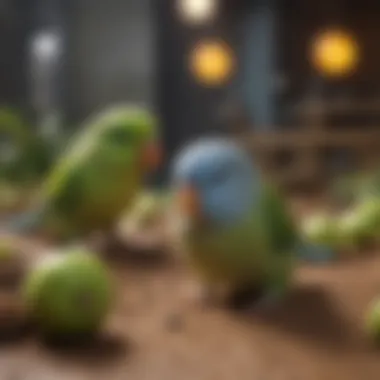
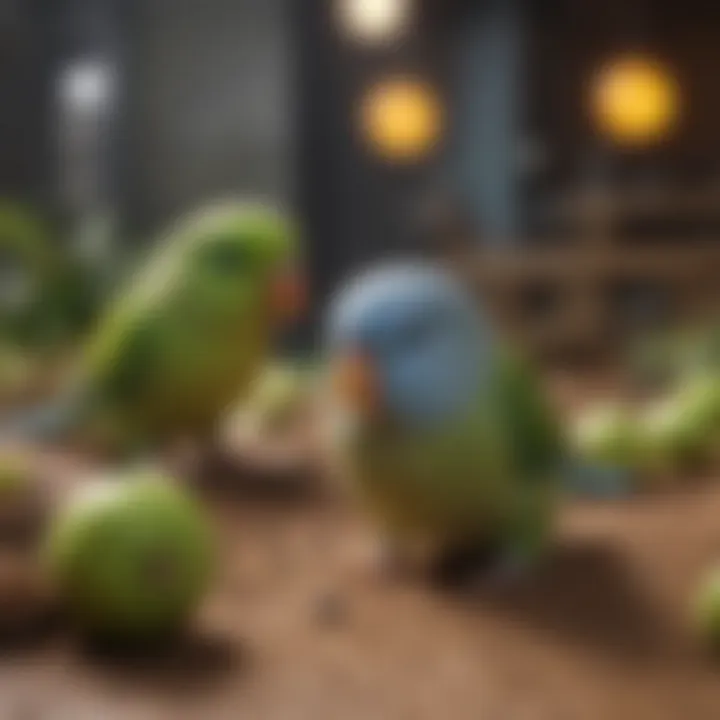
Social Structures in the Wild
In their natural habitat, Pacific Parrotlets exhibit intricate social structures. They are generally seen in pairs or small flocks. This social nature is vital for their survival; they rely on one another for protection against predators and for finding food.
Social interaction among parrotlets includes playful behaviors such as preening and vocalizations. Understandably, when kept in captivity, these birds can become lonely if isolated. Thus, it’s essential for owners to consider having more than one bird or ensuring ample interaction with their feathered friend.
Setting up playdates with other parrot owners or visiting bird clubs can replicate these social structures and promote mental stimulation.
Vocalizations and Communication
Vocalization plays a significant role in a Pacific Parrotlet’s life. These birds are known for their loud, cheerful chirps and the distinct sounds they make to communicate with each other. In the wild, their vocalizations can signal everything from food findings to alerting others of potential threats.
As pet owners, understanding these vocalizations is key. A parrotlet’s call can indicate various feelings, whether they are happy, anxious, or in need of attention. Here are a few typical sounds you might encounter:
- Cheery Whistles: Often a sign of contentment or playfulness.
- Loud Screeches: May indicate stress or a mood change, like a new environment.
- Chirps or Trills: Usually signal curiosity or enjoyment, especially when engaging with their human.
Recognizing these vocalizations helps build a stronger bond between bird and owner. Establishing regular interaction, including talking, singing, and playing sounds, can reinforce communication and strengthen that bond.
"The more you engage with your parrotlet, the more you’ll understand its unique language and behaviors."
By providing an environment that fosters natural behaviors, owners can ensure their Pacific Parrotlets thrive both mentally and physically.
Choosing a Pacific Parrotlet
Selecting the right bird is a cornerstone when diving into the world of Pacific Parrotlets. They’re not just any pet; these little characters bring a good deal of vibrancy and sass to the household. Hence, making the proper choice can greatly influence your relationship and shared experience with these lively creatures. It's vital to understand not only what to look for in a healthy bird but also the expectations and responsibilities that come with owning one of these feathered companions.
Selecting a Healthy Bird
When it comes to picking a Pacific Parrotlet, health should be foremost on your mind. A healthy bird is a happy bird, and you want to avoid any unnecessary heartaches down the road. Here are some indicators that point toward a healthy parrotlet:
- Clear eyes and nostrils: The eyes should be bright, with no discharge from the nostrils.
- Clean feathers: Feathers should be smooth and free of ruffled or missing patches, which can indicate stress or illness.
- Vital weight: Making sure the bird isn't too skinny or overweight is crucial. A healthy bird is neither bony nor overly plump.
- Active and alert behavior: Watch how the bird interacts with its environment. A parrotlet should be lively, curious, and squeeze in some playfulness.
Considering these elements could make all the difference in your ownership experience. Before you choose, spend some time observing the birds in their environment, as their behavior can be a telling sign of their overall health.
Considerations for First-Time Owners
For those dipping their toes into the puddle of bird ownership for the first time, a Pacific Parrotlet might be a great spark for your journey. Keep in mind, however, that every discussion of parrotlets comes with an explicit warning label—though these birds are small, their personalities are anything but.
Here are some pointers to think about:
- Time Commitment: Many new owners underestimate just how much attention these birds need. Expect to spend quality time with your feathered friend. They thrive on interaction and can easily get bored if left alone.
- Space Needs: Even though they’re little, Pacific Parrotlets need a suitable living space. Invest in a decent-sized cage to allow for movement, alongside playtime outside the cage.
- Dietary Considerations: These birds require a balanced diet, including fresh fruits, veggies, and high-quality pellets. Make sure you are ready to manage their dietary needs, as good nutrition is crucial for a thriving parrotlet.
- Understanding Personality: Each bird has its temperament. Familiarizing yourself with their behaviors and quirks will help in crafting a lasting bond.
"Owning a Pacific Parrotlet can be a rewarding experience, but it comes with its share of responsibilities and joys. Understanding what they require paves the way for an enriching companionship."
All in all, taking the leap to welcome a Pacific Parrotlet into your life is a commitment that demands not only preparation but also an open heart to embrace the unique joys and challenges they bring.
Dietary Requirements
Understanding the dietary requirements of the Pacific Parrotlet is critical for their health and happiness. These small birds may be pint-sized, but their nutritional needs are anything but trivial. Without a well-balanced diet, your parrotlet could face a slew of health issues, ranging from obesity to a lack of vital nutrients. Owners must be aware of what to provide and what to avoid to ensure their feathery companions thrive.
Overview of Nutritional Needs
Pacific Parrotlets require a diet rich in various nutrients to support their energetic lifestyle. Vitamins, minerals, proteins, and fiber all play vital roles. A poorly planned diet can not only lead to health complications but also impact their overall demeanor. Tropical fruits and vegetables are particularly important—think leafy greens and colorful bell peppers. These foods not only provide essential vitamins like A, C, and K, but also keep them interested during feeding time.
Parrotlets also need a good balance of carbohydrates and fats for energy. Seeds can be included but should not be the sole component of their diet. Too many seeds can lead to obesity and related diseases.
Recommended Foods and Supplements
Crafting a suitable menu for your parrotlet includes both commercial products and fresh food options. Here are some recommended foods:
- Pelleted Diets: Brands like Harrison's Bird Food and Zupreem offer specially formulated pellets that provide balanced nutrition.
- Fresh Vegetables: Offer a variety of veggies such as carrots, kale, and broccoli. These should make up a significant part of their daily intake.
- Fruits: Consider fruits like apples (without seeds), bananas, and berries as occasional treats. These are high in sugars, so moderation is key.
- Nuts and Seeds: In small quantities, nuts such as almonds or walnuts can be great. Make sure they are unsalted to avoid sodium overload.
- Supplements: Calcium and vitamin supplements can be beneficial, particularly for breeding birds or those in need of extra care. Consult with a vet for appropriate recommendations.
Common Dietary Mistakes
Bird owners often stumble when it comes to feeding their parrotlets. Here are some common pitfalls:
- Over-reliance on Seed Mixes: Many people think seed-based diets are sufficient. However, they lack many essential nutrients needed for a balanced diet.
- Ignoring Fresh Foods: Fresh fruits and vegetables are sometimes neglected, which can lead to deficiencies.
- Portion Control: Giving too much food can lead to obesity. Measure out daily servings and stick to them.
- No Variety: Birds, like people, can get bored with their food. A lack of variety can lead to disinterest in eating altogether, which is detrimental to their health.
"A well-fed parrot is often a happy parrot, but remember, balance is key to prevent diet-related issues!"
By keeping these recommendations in mind and being mindful of common mistakes, you’ll set the foundation for a happy, healthy Pacific Parrotlet. Just like folks feel their best when they eat well, your bird will be livelier, plummier, and ready to charm you with its antics.
Enrichment and Socialization
Enrichment and socialization are not just fancy terms thrown around in pet care manuals; they capture the essence of what it means to have a Pacific Parrotlet as a companion. These birds flourish in environments where they feel emphasized, engaged, and connected. As a small, intelligent species, their need for mental stimulation parallels that of larger birds. Understanding lies in recognizing that enrichment is a vital ingredient that nurtures their physical and mental health.
A well-rounded social life for the Pacific Parrotlet is closely tied to their interactions with humans and other birds. Social interaction is essential for their overall well-being, firing up their natural instincts to explore, communicate, and bond. Without sufficient interaction, these birds may develop behavioral issues or become aloof, thereby diminishing the joy they can bring into our lives. An engaged parrotlet, on the other hand, is likely to display a lively demeanor and exhibit affectionate behaviors, all while establishing a closer bond with its human guardians.
Importance of Social Interaction
The significance of social interaction cannot be overstated. Pacific Parrotlets are known to be social creatures, and they thrive on companionship. Here are a few noteworthy points:
- Prevent Loneliness: Just as humans need company, your feathered friend does too. Feeling isolated can lead to mental distress, so invest time in regular interactions.
- Boost Intelligence: Engaging with your bird stimulates its intellect. Try talking to them, teaching new words, or even playing simple games. It keeps their mind sharp.
- Strengthens Trust: Socializing helps your parrotlet build trust with you, creating a safer atmosphere where they can fully express themselves. A trusting parrotlet is often more willing to explore and bond.
- Encourages Natural Behaviors: When parrotlets interact, they practice natural behaviors such as preening and vocalizing. This not only maintains their health but also showcases their unique personalities.
A well-socialized parrotlet is a happier parrotlet. Make sure you invest time daily - even ten minutes can make a world of difference!
Toys and Activities for Engagement
Boredom is a silent killer of zest for life in pet birds. In tandem with social interaction, proper toys and activities keep your Pacific Parrotlet entertained and engaged.
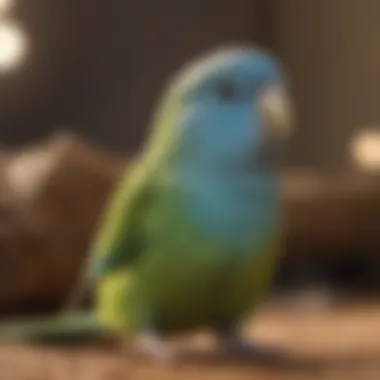
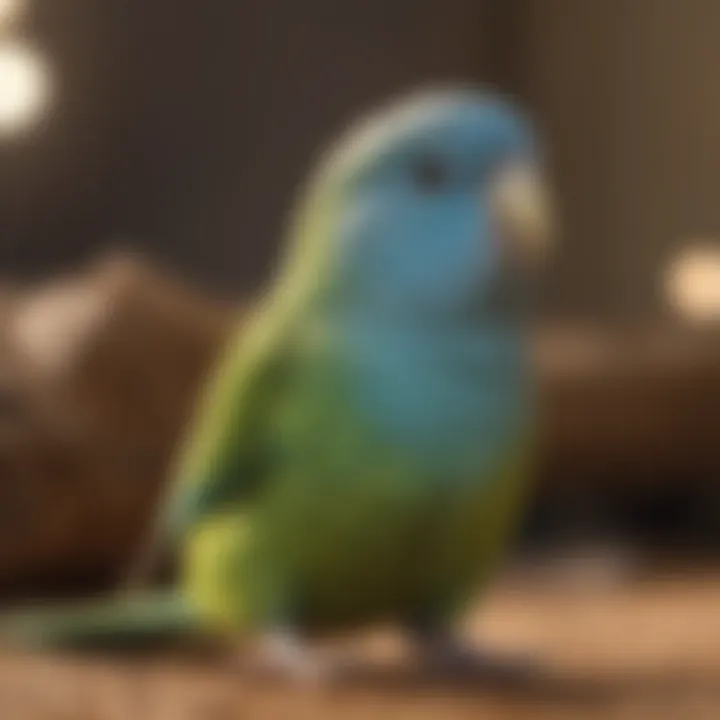
- Safe Chewing Toys: Parrotlets love to chew, so having wooden toys or untreated wicker baskets can satisfy this instinct. It helps maintain their beak health and lets them shred to their heart’s content.
- Interactive Puzzles: Toys that require thought, whether simple or complicated, can give your bird a chance to problem-solve, enhancing their cognition.
- Foraging Activities: Encourage foraging by hiding small treats in paper bags or placing them in a foraging toy. This taps into their natural instincts and keeps them busy for hours.
- Perches and Swings: Offer a variety of perches with different textures and widths. Swings add an element of fun - your parrotlet might just take to the air!
- Scheduled Playtime: Dedicate time for focused play. During this time, you can work on bonding activities, play games, or just let them explore safely around their environment.
In summary, nurturing your Pacific Parrotlet through enriching activities and abundant social interaction is fundamental to their overall happiness and health. With the right approach, you'll be rewarded with a lively companion who fills your space with joy and vivacity.
Health and Wellness
The health and wellness of your Pacific Parrotlet isn't just an afterthought; it’s a cornerstone of responsible pet ownership. Keeping a watchful eye on their health can prevent common ailments and prolong their vibrant lives. Just like humans, these birds can suffer from various conditions if their well-being isn't prioritized. Understanding these issues not only enhances their quality of life but also deepens the bond between bird and owner. It creates a safe environment for them to thrive and express their personalities.
Common Health Issues
Pacific Parrotlets, despite their small stature, can face a range of health issues that pet owners should be aware of:
- Obesity: These birds love to eat, and if not monitored, they can pack on the pounds. Obesity can lead to various health problems, such as heart disease and liver issues.
- Feather Plucking: Sometimes, stress or boredom can lead a parrotlet to pluck its feathers. This behavior is often a cry for help and pops up due to inadequate stimulation or social interaction.
- Respiratory Issues: Parrotlets are sensitive to changes in their environment. Poor air quality, exposure to smoke, or high humidity can trigger respiratory problems. Signs include wheezing or labored breathing.
- Gastrointestinal Disorders: An imbalance in diet can cause issues like diarrhea or prolonged constipation. The wrong kind of food can mess with their digestive system.
- Skin Conditions: Dry skin or dermatitis may occur from poor humidity levels or contact with irritants. Look out for redness, swelling, or discomfort.
Being aware of these issues helps in recognizing them early, which can lead to prompt treatment and a quick recovery for your feathery friend.
Preventive Care and Regular Check-ups
Preventive care is the best medicine for keeping your Pacific Parrotlet healthy. By establishing a regular check-up routine and taking simple preventive measures, you're investing in their longevity:
- Regular Veterinary Visits: Aim for a vet check-up every six months. Regular assessments help catch potential issues before they escalate.
- Monitoring Diet: Providing a balanced diet that includes seeds, pellets, fruits, and vegetables keeps them nourished. Keeping their weight within a healthy range is crucial.
- Observing Behavior: Keep an eye on any changes in habits, vocalizations, or interactions. A shift can indicate discomfort or illness.
- Maintaining Clean Living Conditions: Regularly clean their cage and surroundings. A clean environment reduces the risk of illness and keeps your bird happier.
- Providing Mental Stimulation: Engage them with toys and social activities to keep their minds sharp and ward off problem behaviors..
"An ounce of prevention is worth a pound of cure." Keeping proactive measures in play will save you headaches down the line.
In summary, paying attention to health and wellness is an investment in the lively spirit of your Pacific Parrotlet. With dedication to their care, you can ensure they remain lively companions for years to come.
Training Techniques
When it comes to sharing your life with a Pacific Parrotlet, training isn't just a nice-to-have; it's an essential part of nurturing a well-adjusted bird. These little feathered bundles of energy respond remarkably well to training, which can foster a bond between you and your pet. It can also lead to a more harmonious home environment.
Whether you’re trying to teach simple commands or more complex tricks, the techniques you use will play a major role in your bird's happiness and mental engagement.
Positive reinforcement is an effective and popular method among bird owners, focusing on rewarding desired behaviors instead of punishing unwanted ones. This approach creates a positive atmosphere, crucial given the Parrotlet's curious and energetic nature. By building a solid training routine from the get-go, you can tap into their intelligence and willingness to learn.
Establishing a Training Routine
The first step in training your Pacific Parrotlet is to establish a structured routine. Birds thrive on consistency, and a well-planned schedule can ease the process for both you and your feathery companion.
- Time of Day: Choose a time of day when your bird is most alert and interactive. Many owners find that early mornings or late afternoons work well.
- Duration: Keep training sessions short—around 5 to 10 minutes—so your Parrotlet doesn't lose focus. Young birds especially can become easily distracted, meaning shorter sessions are more effective.
- Frequency: Train frequently but not to the point of fatigue. Aim for daily sessions to reinforce learning without overwhelming your bird.
- Environment: Ensure a distraction-free environment. A quiet room with minimal foot traffic allows for better concentration.
By combining these elements, you lay the groundwork for a successful training experience. Consistency and repetition are the name of the game here.
Positive Reinforcement Strategies
Using positive reinforcement is about rewarding your Pacific Parrotlet for behaviors you want to encourage. Rather than saying "no" when they misbehave, which can lead to confusion and fear, focus on guiding them toward correct behavior. Here are some effective strategies:
- Treats: Identify your bird’s favorite treats—maybe millet, sunflower seeds, or small bits of fruit. Use them as a reward when they perform the desired behavior. Just remember, moderation is important, as too many treats can lead to health issues.
- Praise: Your Parrotlet can interpret your tone of voice and body language. Use a gentle voice and enthusiastic gestures when your bird does something right. This creates a positive feedback loop that they learn to associate with good behavior.
- Clicker Training: This method involves using a small handheld clicker to mark the desired behavior, immediately followed by a reward. The click sound becomes a cue that indicates they did something right.
By focusing on training techniques that appeal to your Parrotlet's instincts and natural behaviors, you ensure a nurturing and stimulating environment where your pet can thrive. Establishing a solid routine coupled with positive reinforcement strategies can lead to a rewarding interaction and a fulfilling life for both you and your feathered friend.
Creating a Suitable Habitat
Creating a suitable habitat for a Pacific Parrotlet is fundamental to their overall health, happiness, and well-being. These little birds boast vibrant personalities and considerable intelligence, and providing the right environment is essential to allow them to thrive both physically and socially. A well-thought-out habitat can prevent behavioral issues, establish a routine, and enhance the bond between the bird and its owner.
Cage Requirements and Setup
When setting up a cage for a Pacific Parrotlet, size does matter, despite their small stature. Ideally, a cage of at least 24 inches in width is advisable. This provides ample space for movement and prevents the bird from feeling confined. Bars should be spaced no wider than ½ inch to prevent any accidental escapes. In terms of layout, it is wise to place perches at varying heights and include swings to promote exercise.
Consider these essential aspects when designing your setup:
- Perches: Use a variety of perches made from natural wood to offer tactile stimulation and help maintain foot health. Avoid using sandpaper perches, as they can cause injury.
- Food and Water Containers: Secure bowls at the appropriate height to encourage your bird to eat and drink comfortably. Make sure they are easy to clean, as hygiene is key in preventing diseases.
- Hiding Places: Adding small huts or boxes can provide shelter and a sense of security for your Pacific Parrotlet, allowing it to retreat when it feels overwhelmed.
- Safety Measures: Ensure any toys or materials used are bird-safe and free of harmful paints or chemicals. Avoid plastic materials when possible.
The goal is to create a setup that mimics their natural environment, allowing them to exhibit natural behaviors.
Environmental Enrichment
Birds, like Pacific Parrotlets, are naturally curious and intelligent creatures. Therefore, environmental enrichment is critical for their mental well-being. Enrichment includes activities or items that stimulate the bird's instincts to engage and explore.
Here's how you can boost the environment for your feathered friend:
- Toys: Rotate different toys regularly to keep their interest piqued. Look for interactive toys that puzzle or challenge them, like foraging toys that require effort to retrieve a treat.
- Social Interaction: Birdies are social creatures. Having regular interaction with their human family is crucial. Consider training sessions or engaging in playtime outside of their cage.
- Variety in Activities: Offer opportunities for activities like climbing, swinging, and even bathing on occasion. Some birds enjoy misting with a spray bottle—just ensure your bird is comfortable with it.
Enrichment is not merely a luxury for pet birds; it is a necessity that caters to their physical, social, and cognitive needs.
Creating a habitat that emphasizes both proper cage setup and enriching experiences will not only enhance the Pacific Parrotlet’s life but also deepen the bond between pet and owner, sculpting an environment where the bird can flourish.
Finale
In wrapping up our exploration of the Pacific Parrotlet, it’s crucial to reflect on the significance of the insights gathered throughout this article. Understanding these remarkable birds goes far beyond casual observation; it involves a deep dive into their behaviors, needs, and overall well-being. Embracing this knowledge is paramount for prospective and current owners alike. Not only does it enhance the relationship between the bird and its human family, but it also sets the stage for a fulfilling and enriching experience for both.
Summary of Key Points
As we conclude, let’s summarize the key takeaways:
- Physical Characteristics: The Pacific Parrotlet is small, yet vibrant, exhibiting a diverse palette of colors.
- Natural Habitat: Understanding their geographic distribution helps provide a more authentic environment at home.
- Dietary Needs: A balanced diet is essential; knowing what to feed them can prevent many health issues.
- Socialization: These birds thrive on interaction; neglecting their social needs can lead to behavioral problems.
- Health and Wellness: Regular vet check-ups can catch issues early, ensuring a longer, healthier life.
With these points in mind, it reinforces the idea that being informed is the first step in responsible pet ownership.
Future Considerations for Owners
As you consider welcoming a Pacific Parrotlet into your home, keep several factors in your mind:
- Long-Term Commitment: These birds can live up to 20 years or more. Be prepared for the long haul.
- Environmental Needs: Create a habitat that reflects their natural setting, including adequate space and enrichment.
- Continuous Learning: Stay updated with new information and techniques in bird care and training. Forums like Reddit can be great for current discussions.
- Bonding Activities: Regular playtime and training not only stabilize their behavior but also enhance your bond.
Understanding the Pacific Parrotlet is a journey that requires diligent observation and regular adaptation to their evolving needs. These birds are not just pets; they are vibrant members of the family that deserve a nurturing environment and committed care. Through knowledge and engagement, you’ll likely find that your experience with these charming creatures enriches your life tremendously.















